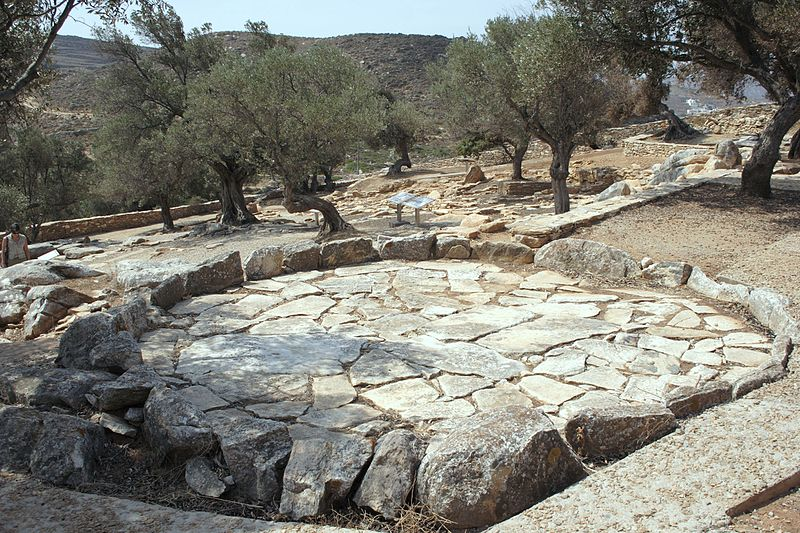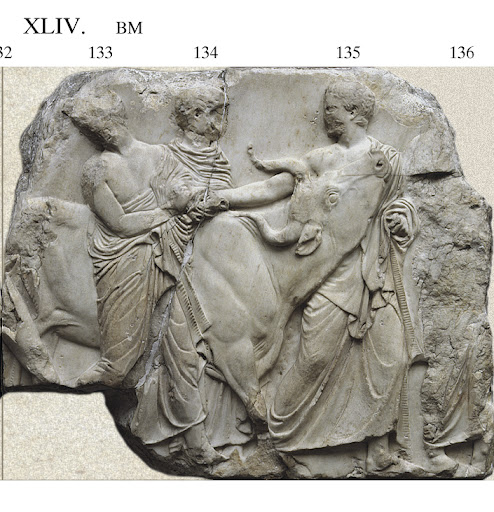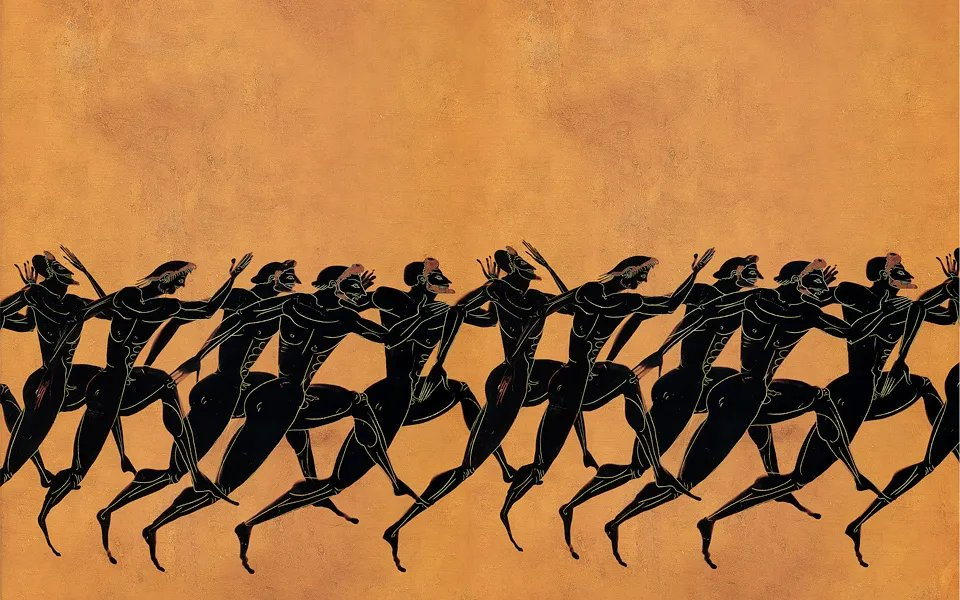Threshing floor, Naxos, Greece...
Today, while reading "Delphi and Cosmovision: Apollo's Absence At the Land of the Hyperboreans and the Time for Consulting the Oracle", I discovered that Delphic calendar started with the month of Apellaios, the month dedicated to Apollo. As you would expect it to be in Delphi, The Apollo Central...
But what I didn't expect to see is that in Delphi, Apellaios started with the first new moon after summer solstice, which means that this month of Apollo basically covered Jul/Aug, Leo...Why? Cause this is another confirmation that Apollo was indeed, like I suggested, Nergal...
Who's Nergal? This dude:
Nergal, the deified destructive "burning" sun, was depicted as a lion man, because Jul/Aug, Leo, is the hottest and driest part of the year in Mesopotamia...
Talked abut him in my post "Winged superhuman hero", "Palil", "Lord of flies", "Angra Mainyu"...and many other...
In Greece, the "terrible" sun, Shamash as Nergal, became Apollo. The "terrible" sun god Apollo..."As he [Apollo] goes through the house of Zeus, the gods tremble before him and all spring up from their seats when he draws near, as he bends his bright bow". This is an excerpt from the Homeric "Hymn to Delian Apollo"...
I explained why Apollo was so terrible, and why everyone was so scared shitless when he was around, in my post "Lions of Delos" about the lions from the 600 BC Temple of Apollo from Delos.
No wonder then that this month of the terrible Apollo was also the main time to perform Hekatomb, the sacrifice of 100 bulls to Apollo, the (Lion/Dragon) god...
Lion killing bull...The scene we see depicted all over the Old World, with no explanation...Like on this coin from Cilicia, Tarsos Mazaios Satrap 361-334BC...Autumn (starts in Leo) ends (kills) summer (starts in Taurus)...
The animal calendar marker marking Jul/Aug, Nergal time.
Some posts that talk about the meaning of the "Lion killing bull" scene: "Mystery seal", "Cypriot stamp seal with cow and calf", "Black basalt stone of Esarhaddon", "Angra Mainyu", "Bull leaping in Syria", "Adda seal", "Lion killing bull under date palm", "Butt chewing"...
Those wondering why Apollo, the Dragon god...Check my post "Marble throne of Apollo" out.
Marble Throne of Apollo, Roman, late 1st c. AD. Currently in the Los Angeles County Museum of Art
Whoever made this, knew who Apollo really was and wanted to show Apollo in his true shape (serpent, dragon), sitting on his throne.
Anyway, why did I start this post with a picture of a threshing floor? Because the word Apellaios is derived from the Doric word apella (ἀπέλλα) which originally meant wall, enclosure of stones, and later assembly of people within the limits of this enclosure...
Threshing floors (circular walled enclosures) were used as communal gathering places until recently. So I wonder if the original "apellas" took place on threshing floors? I talked about it in my posts "Shield of Achilles", "Oro", "Bogovo gumno, God's threshing floor"...
Threshing floors were also used as solar observatories, and The First Temple in Jerusalem, which later, according to the Jewish sources, turned out to be a solar temple, most likely dedicated to Shamash, was built on a threshing floor.
If you wanted to make a (First) Temple on a Threshing Floor, and "orient" it (make it to face east), if you wanted to make a "House of God" to face the "House of (Sun) God", how would you do it?
I taled about this in my posts "Sun god from the first temple", "Boaz and Jachin", "The tree of life/light", "Menorah from Nipur"...
Threshing floors were also used as ceremonial platforms. I talked about this in my post "Sacred marriage on the threshing floor" and "Jerusalem of gold".
And so it is not surprising that in Delphi we also find a sacred threshing floor.
This threshing floor (Halos), marks the spot where Apollo killed Python. Did Apollo (sun god) kill Python (solar snake) on a threshing floor (solar observatory)? Anyways, this threshing floor was the place where plays honouring Apollo were staged.
This threshing floor was also the place where Septerion, the ritual re-enactment of the murder of Python by Apollo, took place once every eight years.
Hmmm...According to Hesiod threshing in Greece took place around the time of the summer solstice. I talked about this in my post "Hesiod on grain". Which is why the new year started right after that, during the month of Apollo...
Apellaios, Jul/Aug, Leo, when, according to "Pindar's Paeans: A Reading of the Fragments with a Survey of the Genre", Septerion ritual took place, right before the start of the Pythian games, which took place in August...
BTW, what did that hut, that was supposed to represent Python's lair, look like? No one knows...Like this I presume?
Like a bonfire...
Like bonfires still lit all over Europe around Summer Solstice...
Sometimes with the solar wheel placed on top of it...Talked about it in my post "Burning rolling wheel"
So, in Jul/Aug, the hottest time of the year in Greece, Greeks celebrated the victory of the (destructive) Sun God Apollo over a dragon (symbol of the destructive sun's heat) by lighting a bonfire 🙂, on a threshing floor (solar observatory) using torches...🙂 Funny that...
You might also like my post about the black and white ravens of Apollo, another strange Apollo legend which has its parallel in Nergal legends and which can only be explained through animal calendar markers.
In this post you will find that "the gates of hell" in Mesopotamia were guarded by twins, linked to Gemini constellation, and "closely related to Nergal"...
Just like Dioskuri who guard Summer Solstice, the gates of Apellaios, Jul/Aug, Time of Apollo, the Scary God of art and music and healing...Apparently...
That's it. To read more about ancient animal and plant calendar markers, start here…Then check my twitter threads I still didn't convert to blog post...I am way way behind...



















Hi, I'm a British ecologist and artist looking for evidence of ancient ecological knowledge in megalithic art. I find your theories to be very plausible.
ReplyDeleteHave you looked at the "serpent stones" of pictish scotland? I don't know much about them but to my eye, they seem to depict an adder coiled around a broken arrow. To my mind it's fairly plausible to imagine that they may be symbolising the sun/summer here, following a similar tradition to that which you outlined in this article on apollo and the other one you did on the serpent as a seasonal marker.
I might be seeing things, but it seems to me that the "broken arrow" (as is my interpretation of the zigzag symbol that accompanies the snake on these stones) bears some resemblance to the "bow" constellation formed by sirius and the surrounding stars....
Let me know what you think!
Hi Max. I am glad you like my scribbles. You might find these interesting
Deletehttps://oldeuropeanculture.blogspot.com/2020/01/balluderon-stone.html
https://oldeuropeanculture.blogspot.com/2022/08/goose-salmon-stone.html